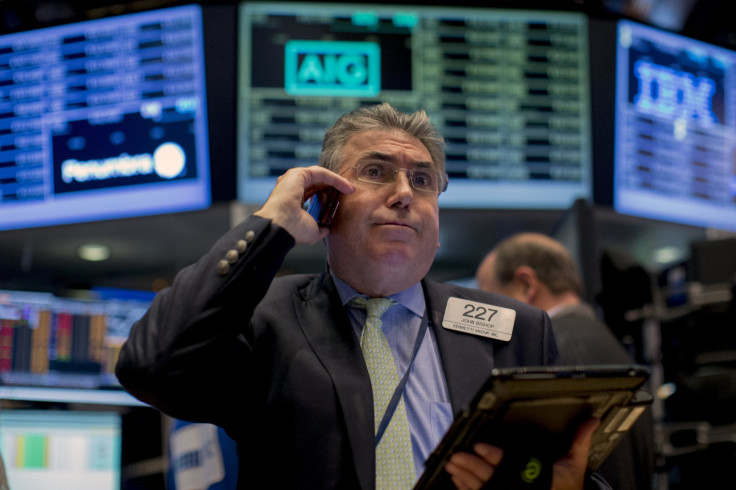Dow Jones Industrial Average Fluctuates As Wall Street Weighs The Federal Reserve's Looming Rate-Hike Decision

U.S. stocks closed higher Friday after fluctuating during afternoon trading as investors weighed a series of mixed data and earnings reports, pointing to expectations the Federal Reserve will delay a rate hike this year. The likelihood of the Fed hiking borrowing costs before the end of 2015 diminished again this week after two top Fed officials came out strongly in favor of delaying a rate hike until next year, while mixed retail sales and inflation data triggered sizable downgrades to estimates of third-quarter gross domestic product growth.
The Dow Jones Industrial Average (INDEXDJX:.DJI) added 74.22 points, or 0.43 percent, to close at 17,215.97. The Standard & Poor's 500 index (INDEXSP:.INX) added 9.24 points, or 0.46 percent, to finish at 2,033.10. The Nasdaq composite (INDEXNASDAQ:.IXIC) rose 16.59 points, or 0.34 percent, to end at 4,886.69.
U.S. stocks closed higher for the third straight week, with the Dow adding 0.8 percent, or 133 points. The S&P 500 index added 0.9 percent, or 18 points and the Nasdaq rose 1.1 percent, or 56 points.
Wall Street closed sharply higher a day earlier, with the blue-chip Dow leaping more than 200 points after William Dudley, the president of Federal Reserve Bank of New York, said recent data suggests the U.S. economy is slowing, pushing out market professionals' expectations for the central bank to raise rates this year.
Capital Economics forecasts third-quarter U.S. GDP growth to come in at a 1.5 percent annualized pace, and overall growth for the year close to 2.4 percent.
“Our view is that the Fed will now wait until next year, most probably March,” Paul Ashworth, chief U.S. economist at Capital Economics, said in a research note Friday. However, the longer the Fed waits, the faster it will eventually need to hike rates to combat what could now be a very rapid rise in inflation next year, Ashworth warned.
Oxford Economics also trimmed the odds for December rate lift-off to 50 percent from 55 percent this week.
“Our base case remains that domestic momentum and gradually firming inflation will lead the Fed to lift rates in December. However, there is a real risk that the headwinds of weak global growth, the strong dollar, and lower oil prices will delay lift-off until next year,” Gregory Daco, head of U.S. macroeconomics at Oxford Economics, said in a note.
Wall Street continued to eye third-quarter earnings season, an important measure as it provides an updated read on the pace of economic growth, both at home and abroad, as reflected by company releases.
"It is likely to impact near-term price swings of equities, impacting sentiment and perhaps weighing on the Fed’s looming rate lift-off date," U.S. Bank Wealth Management said in its weekly Market & Economics report.
Shares of Dow component General Electric Company (NYSE:GE) gained more than 2 percent after the multinational conglomerate turned in quarterly earnings above Wall Street forecasts, while revenues fell short of estimates.
Seven of the 10 sectors in the Standard & Poor's 500 index traded higher, led by a 1 percent gain in consumer staple stocks, while the energy sector was the largest laggard, down 0.5 percent.
The Dow Jones Transportation Average traded more than 1 percent lower, led by losses from regional U.S. railroad Kansas City Southern (NYSE:KSU), which sank 8.5 percent.
U.S. consumer sentiment came in higher than expected in October, rising to a three-month high, signaling a rebound in confidence amid recent concerns of a slowing global economy.
The University of Michigan's preliminary October reading came in at 92.1, higher than the previous month's reading of 87.2. Experts were forecasting for the reading to come in at 89, according to analysts polled by Thomson Reuters.
The rebound in the University of Michigan's consumer confidence survey in October reflects the sharp decline in gasoline prices over the past month and the fading turmoil in stock markets.
Separately, a decline in industrial production in September suggests the impact the stronger U.S. dollar is having on manufacturing and the effects the slump in energy prices is having on mining output. Industrial output fell 0.2 percent after a revised 0.1 percent decline in August, the Federal Reserve said Friday.
© Copyright IBTimes 2024. All rights reserved.





















